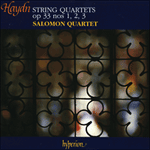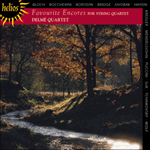
Welcome to Hyperion Records, a British classical label devoted to presenting high-quality recordings of music of all styles and from all periods from the twelfth century to the twenty-first.
Hyperion offers both CDs, and downloads in a number of formats. The site is also available in several languages.
Please use the dropdown buttons to set your preferred options, or use the checkbox to accept the defaults.

| Salomon Quartet» More |
Contradicting its title of Scherzo—and the usually bright, ‘open’ key of C major—the tenderly veiled second movement transmutes a dance into a hymn or prayer, with the four instruments playing sotto voce on their lowest strings. With comical incongruity, the trio resumes the first movement’s avian associations with a twittering duet for the two violins on their high A and E strings. The serene, warmly textured Adagio, in condensed sonata form (with a brief transition instead of a central development), surely left its mark on the slow movement of Mozart’s ‘Dissonance’ Quartet, K465, in the same key. Instead of literally repeating the first section, Haydn varies it with floridly expressive figuration for the first violin: a touchstone for the player’s ‘taste’ and imagination.
The rondo finale is Haydn at his most antic. Its manic refrain, oscillating obsessively between G and E, derives from a Slavonic folk dance. After the tune has tumbled down from first violin to cello, Haydn swerves into an impassioned episode in Hungarian gypsy style. But the mood is quickly punctured by the irrepressible, hyperactive folk tune. The coda is pure slapstick, with a fragment of the theme bandied about between upper and lower instruments before the music seems to disappear into thin air.
from notes by Richard Wigmore © 2013
En contradiction avec son titre de Scherzo—et avec la tonalité généralement brillante «sans altération à la clef» d’ut majeur—le deuxième mouvement tendrement voilé transmue une danse en hymne ou en prière, les quatre instruments jouant sotto voce sur leurs cordes les plus graves. Avec une incongruité comique, le trio reprend les évocations aviaires du premier mouvement avec un duo gazouillant des deux violons sur leurs cordes aiguës de la et de mi. L’Adagio serein à la texture chaude, en forme sonate condensée (avec une courte transition au lieu d’un développement central), a sûrement influencé le mouvement lent du Quatuor «Les Dissonances», K 465, de Mozart, dans la même tonalité. Au lieu de reprendre littéralement la première section, Haydn la varie avec une figuration expressive fleurie au premier violon: une pierre de touche pour le «goût» et l’imagination de l’instrumentiste.
Le rondo final est du Haydn le plus cocasse. Son refrain frénétique, qui oscille de manière quasi obsessionnelle entre sol et mi, s’inspire d’une danse folklorique slave. L’air dévale en cascade du premier violon au violoncelle, puis Haydn fait une embardée pour entrer dans un épisode passionné en style tzigane hongrois. Mais l’atmosphère est vite détruite par la mélodie populaire exubérante et hyperactive. La coda est une pure comédie bouffonne, avec un fragment du thème échangé entre les instruments aigus et graves avant que la musique semble se volatiliser.
extrait des notes rédigées par Richard Wigmore © 2013
Français: Marie-Stella Pâris
Im Widerspruch zu seinem Titel Scherzo—und der normalerweise hellen, „offenen“ Tonart C-Dur—verwandelt der sanft verschleierte zweite Satz einen Tanz in ein Kirchenlied oder ein Gebet, wobei die vier Instrumente auf ihren tiefsten Saiten sotto voce spielen. Mit komischer Inkongruenz nimmt das Trio mit einem zwitschernden Duett für die beiden Geigen auf ihren hohen A- und E-Saiten die Vogel-Assoziationen des ersten Satzes wieder auf. Das heitere, warm strukturierte Adagio, das in komprimierter Sonatenform angelegt ist (mit einer kurzen Überleitung anstelle einer zentralen Durchführung), war sicherlich ein Einfluss auf den langsamen Satz von Mozarts „Dissonanzenquartett“ KV 465 in derselben Tonart. Anstatt den ersten Abschnitt wortwörtlich zu wiederholen, variiert Haydn ihn mit blumig-expressiven Figurationen in der ersten Geige: ein Prüfstein für den „Geschmack“ und die Phantasie des Interpreten.
Das Finale, ein Rondo, zeigt Haydn in besonders possenhafter Laune. Dem manischen Refrain, der wie besessen zwischen G und E hin- und herpendelt, liegt ein slawischer Volkstanz zugrunde. Nachdem die Melodie von der ersten Geige hinunter zum Cello gepurzelt ist, macht Haydn einen Schlenker in eine leidenschaftliche Episode hinein, die sich durch den ungarischen Zigeunerstil auszeichnet. Doch wird die Stimmung bald durch die unbändige, hyperaktive Volksmelodie durchkreuzt. Die Coda ist die reinste Slapstick-Komödie, wobei ein Themenfragment zwischen oberen und unteren Instrumenten umhergeworfen wird, bevor die Musik sich in Luft aufzulösen scheint.
aus dem Begleittext von Richard Wigmore © 2013
Deutsch: Viola Scheffel
 Haydn: String Quartets Opp 33/1-3 Haydn: String Quartets Opp 33/1-3‘Virile, colourful performances … sharply responsive to the music's robust earthiness and gleeful unpredictability’ (Gramophone) 'Assolutamente magnifica' (Musica, Italy)» More |
 Favourite Encores for string quartet Favourite Encores for string quartet‘How many string quartets play encores? Those that don't should have a listen to the Delmé Quartet's highly entertaining selection. The playing is exc ... ‘This is quite magnificent’ (CDReview)» More |

